ICSE 10th Biology Question Paper 2023 with Solutions: The ICSE Class 10 Biology Exam 2024 is scheduled for March 18 (Monday). Students preparing for the ICSE Class 10 Science Paper 3 should not miss the practice of the previous year’s ICSE Class 10 Biology question paper. Solving last year’s question paper will help to get familiarised with the questions' format and important topics to be revised for the upcoming board exam. In this article, we have provided the solved Biology question paper for the ICSE Board Exam 2023. All the questions have been thoroughly solved which will help in the quick and effective revision at the last moment before the upcoming exam. All questions and answers are available for free and can be saved as PDF for convenient offline access and further practice.
Question 1. Select the correct answer to the questions from the given options.
Answer:
| Q.No. | Answers | Q.No. | Answers |
| i | (a) | ix | (c) |
| ii | (d) | x | (a) |
| iii | (c) | xi | (b) |
| iv | (b) | xii | (d) |
| v | (c) | xiii | (b) |
| vi | (d) | xiv | (a) |
| vii | (a) | xv | (c) |
| viii | (b) |
|
|
For questions, check ICSE Class 10 Biology Question Paper 2023
Question 2. (i) Name the following
(a) The organelle that forms the aster during cell division.
(b) A genetic disorder in which the blood does not clot.
(c) The permanent stoppage of menstruation in human females around the age of 45 years.
(d) The openings on the barks of trees through which transpiration occurs.
(e) A gaseous plant hormone which promotes ripening of fruits.
Answer:
(a) Centrosomes
(b) Haemophilia
(c) Menopause
(d) Lenticels
(e) Ethylene
(ii) Arrange and rewrite the terms in each group in correct order to be in a logical sequence beginning with the term that is underlined:
(a) Snake, Rabbit, Cabbage, Hawk.
(b) Xylem, Soil water, Cortical cells, Root hair.
(c) Receptor, Response, Effector, Spinal Cord.
(d) Fovea, Lens, Cornea, Conjunctiva.
(e) Testis, Urethra, Sperm duct, Epididymis
Answer:
(a) Cabbage, Rabbit, Snake, Hawk
(b) Soil water, Root hair, Cortical cell, Xylem
(c) Receptor, Spinal cord, Effector, Response
(d) Conjunctiva, Cornea, Lens, Fovea
(e) Testis, Epididymis, Sperm duct, Urethra
(iii) Match the items given in Column I with most appropriate ones in Column II and rewrite the correct matching pairs:
| Column A | Column B |
| (a) Hyposecretion of Thyroxin in adults (b) Hyposecretion of Insulin (c) Hypersecretion of GH in childhood (d) Hyposecretion of ADH (e) Hypersecretion of Thyroxine | 1.Diabetes insipidus 2.Myxedema 3.Dwarfism 4.Gigantism 5.Diabetes mellitus 6.Exophthalmic goitre. 7.Cretinism |
Answer:
| Column A | Column B |
| (a) Hyposecretion of Thyroxin in adults (b) Hyposecretion of Insulin (c) Hypersecretion of GH in childhood (d) Hyposecretion of ADH (e) Hypersecretion of Thyroxine | 2.Myxoedema 5.Diabetes mellitus 4.Gigantism 1.Diabetes insipidus 6.Exophthalmic goitre |
(iv)Choose the odd one out from the following terms and name the category to which the others belong.
(a) Used bandages, Pesticides, Face masks, Syringes.
(b) Dust, Smoke, Carbon monoxide, Effluents.
(c) Uterus, Urethra Urinary bladder, Ureter
(d) Menstrual phase, Telophase, Follicular phase, Luteal phase.
(e) Malleus, Incus, Cochlea, Stapes.
Answer:
| Odd one name | Category name for others |
| (a) Pesticides | Medical waste (Used garbage, face mask, syringes) |
| (b) Dust | Industrial air pollutants (Smoke, CO, effluents) |
| (c) Uterus | Organs of urinary system( Urethra, urinary bladder, ureter) |
| (d) Telophase | Stages of menstrual cycle (menstrual phase, follicular phase, Luteal phase) |
| (e) Cochlea | Middle ear bones (Malleus, incus, stapes) |
(v) State the exact location of the following structures:
(a) Thyroid gland
(b) Dura mater
(c) Amniotic fluid
(d) Papillary muscles
(e) Islets of Langerhans
Answer:
| Structure name | Location |
| (a) Thyroid gland | Visceral compartment of neck. |
| (b) Dura mater | Outermost meninges of the skull |
| (c) Amniotic fluid | In an amniotic sac surrounding the fetus. |
| (d) Papillary muscles | In the cavity of the ventricles of heart |
| (e) Islets of Langerhans | Pancreas |
Question 3.
(i) Write the overall chemical equation for photosynthesis
(ii) Mention any two functions of blood.
(iii) Differentiate between Karyokinesis and Cytokinesis.
(iv) Excessive use of fertilisers in agricultural fields reduces the yield of crops. Justify the statement.
(v) Study the diagram given below and answer the questions that follow:
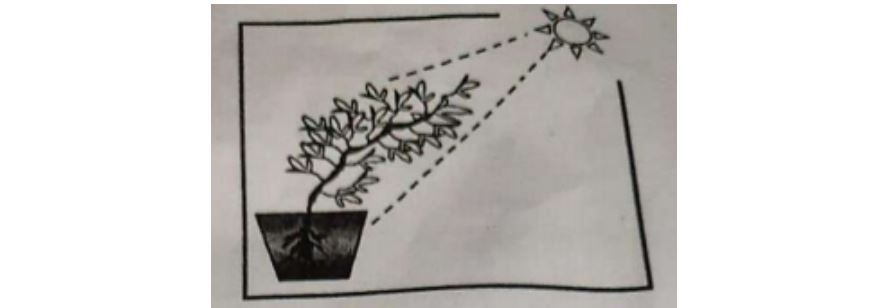
(a)Name the phenomenon depicted by the shoot in the above diagram.
(b) Which plant hormone plays an important role in the above movement?
(c) Complete and rewrite the given statement by filling in the correct terms:
Shoots show positive __________ whereas, roots show positive _________
Answer:
(i) Chemical equation of photosynthesis
(ii) Functions of blood-
(a) It helps to transport oxygen and hormones throughout the body.
(b) It helps to transport absorbed nutrition all over
the body.
(iii) Karyokinesis: Karyo means nucleus and kinesis means division so the division of nucleus is called karyokinesis.
Cytokinesis: Division of cytoplasm followed by karyokinesis at the end of the cell cycle is called cytokinesis.
(iv) Excessive use of fertilisers affect the soil fertility as well as the productivity of the soil. Fertilisers also destroys the rich nutrients of the soil. Thus it is true to say that excessive use of fertilisers in agricultural field reduces the yield of the crop.
(v)(a) Photoperiodism
(b) Auxins
(c) Shoots show positive phototropism and roots show positive geotropism.
Question 4.
(i) Explain the abbreviation - DNA.
(ii) What is Active transport?
(iii) Mention the two pairs of nitrogenous bases which pair with each other with hydrogen bonds.
(iv) State Mendel's Law of Segregation'.
(v) Draw a neat, labelled diagram of a human sperm.
Answer:
(i) DNA: Deoxyribonucleic Acid.
(ii) Active transport: The movement of molecules across the permeable membrane in the direction of lower concentration with the utilisation of energy.
(iii) Pairs of nitrogen bases are A-T and G-C .
(iv) Law of segregation: According to this law, during gamete formation each allele of a gene segregate or separate from each other to ensure only a single allele for a single gene.
(v)Structure of male sperm:
Question 5.
(i) Explain the term 'Population density'.
(ii) Name the two surgical methods of population control.
(iii) Mention two factors responsible for population explosion in India.
(iv) Name any two resources which come under pressure due to rising population.
(v) The diagram given below depicts the climate change on plant Earth.
Answer the following questions:
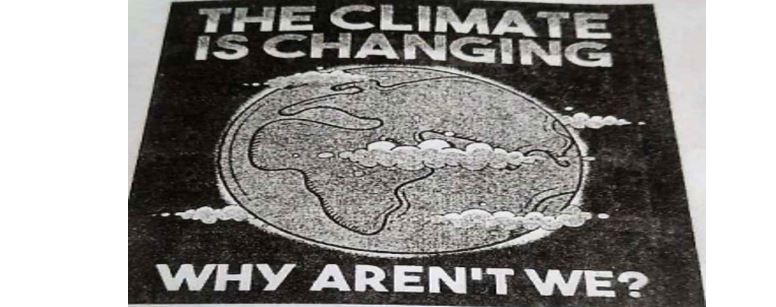
(a) Name the climate phenomenon for the increase in Earth's temperature.
(b) Mention one reason for this warming.
(c) What measure can be taken to prevent this climate change?
Answer:
(i) Population density: The number of individual or people per unit area is called population density.
(ii) Vasectomy (in males) and Tubectomy (in females) are the surgical methods of population control.
(iii) Factors responsible for population explosion can be-
- Less awareness about the control measure and family planning.
- In most of the families desire for male child.
(iv) Many resources come under pressure due to rise in population such as water, food, etc.,
(v) (a) Global warming
(b) Reasons for global warming can be:
- High emission of greenhouse gases.
- Due to deforestation, harmful gases cannot be trapped.
(c) Measures to prevent climate changes are-
- Afforestation (plant more and more trees).
- Reduces the fossil fuel consumption.
- Save water and electricity.
Question 6.
(i) Define the term Transpiration.
(ii) State any two adaptations in plants to reduce transpiration.
(iii) Mention any two function of the human foetal placenta.
(iv) What is the significance of the human testes being located in scrotal sacs outside the abdomen?
(v) Draw a neat, labelled diagram of Malpighian capsule.
Answer:
(i) Transpiration: The loss of water from the surface of leaf through stomata and from lenticels in the stem.
(ii) Adaptation: Sunken stomata in xerophyte and cuticle layer reduces the rate of transpiration.
(iii) (a) Placenta provide nutrition and oxygen to the fetus from the mother.
(b) Remove the waste produced in the fetus.
(iv) In human males, testis are located outside the abdominal cavity because testis require 2°C less temperature than the body temperature for the formation of sperms.
(v) Structure of malpighian capsule:
Question 7.
(i) What is a Reflex action?
(ii) Renal cortex has a dotted appearance and Renal medulla has a striped appearance. Explain.
(iii) What are the two functions of cerebellum.
(iv) Distinguish between Semicircular canals and Utriculus based on their function.
(v) A potted plant with variegated leaves was kept in dark for 24 hours and then placed in bright sunlight. Answer the following questions:
(a) Which aspect of photosynthesis is being tested in the above diagram?
(b) Why was the plant kept in dark for 24 hours?
(c) After the starch test what will be the colour of the yellow and green parts of the leaf? Give reasons to support your answer.
Answer:
(i) Reflex action: It can be defined as the automatic and mechanical response to a stimulus, acting on a specific receptor, without desire of an individual.
(ii) Renal cortex has a dotted appearance due to to the presence of convoluted parts of the tubule (proximal and distal convoluted tubules) whereas the renal medulla has striped appearance due to the presence of tubular part of the nephron.
(iii) Functions of cerebellum:
- It coordinates muscular activities or voluntary action.
- It maintains equilibrium of the body.
(iv) Semicircular canal is a fluid filled canal that helps in balancing, while the utriculus canal is located near the inner ear and helps in orientation and static equilibrium.
(v) (a) The necessity of chlorophyll was tested.
(b) The plant was kept in dark for destarching that is to remove all the starch from the leaves.
(c) After performing test the pale yellow portion of a leaf showed a negative result for the presence of starch and the green portion of leaf showed positive result as it turns blue- black in colour. This experiment prove that chlorophyll (green pigment) is necessary for photosynthesis.
Question 8.
(i) Define the term Mutation.
(ii) A pure breeding red flower variety of pen plant (RR) is crossed with a pure breeding white flower variety of pea plant (rr).
Draw a Punnett square to find out the Phenotypic and Genotypic ratios of the progeny belonging to the F2 generation.
(iii) Leaves of certain plants roll up on a hot sunny day. Explain by giving suitable reasons.
(iv) What is the semi permeable membrane?
Name the semi permeable membrane present in a plant cell.
(v) The diagram below depicts the human heart in one of its phase.
Answer the questions that follow:
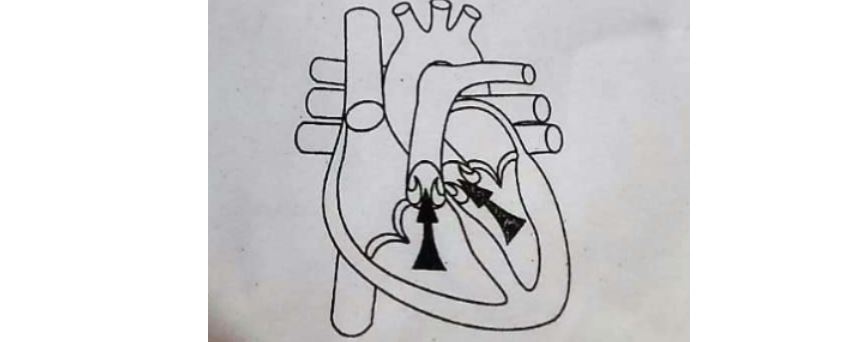
(a) Which part of the heart is in the contraction phase?
(b) Give a suitable reason to justify your answer in (a).
(c) Distinguish between Systole and Diastole.
Answer:
(i) Mutation: A sudden change in the base pair sequences of DNA due to the various factors such as radiation, chemical, etc.
(ii) Phenotypic ratio in F2 generation is 3:1
Genotypic ratio in F2 generation is 1:2:1
(iii) Leaves of some plants roll up on a bright sunny day to reduce the effective surface area for transpiration. The reduced surface area ultimately reduces the rate of transpiration.
(iv) Semi-permeable membrane: The membrane which allows only certain molecules to pass through them by simple diffusion process. In plant cell, plasma membrane is semi-permeable.
(v) (a) Ventricular phase is contracting phase in the heart.
(b) Ventricles contract to pump blood forcefully to the aorta and pulmonary artery.
(c) Systole occurs when the heart contracts to pump blood out, and diastole occurs when the heart relaxes after contraction.
Download all questions and answers below:
ICSE Class 10 Biology Question Paper 2023 with Solutions PDF |
Also Check:

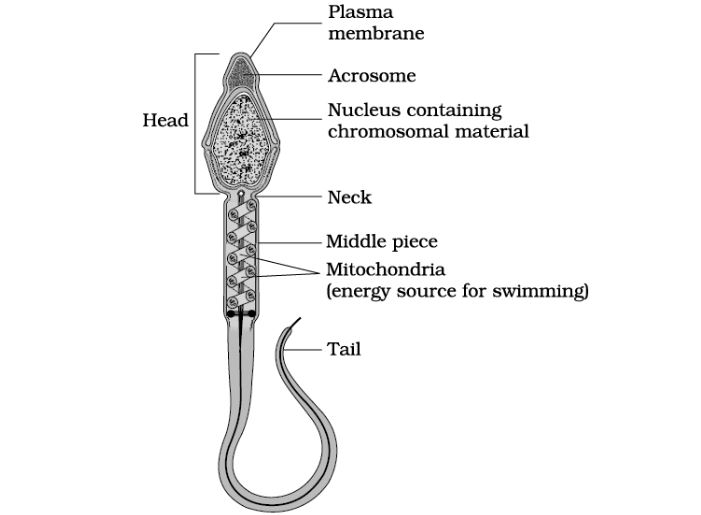
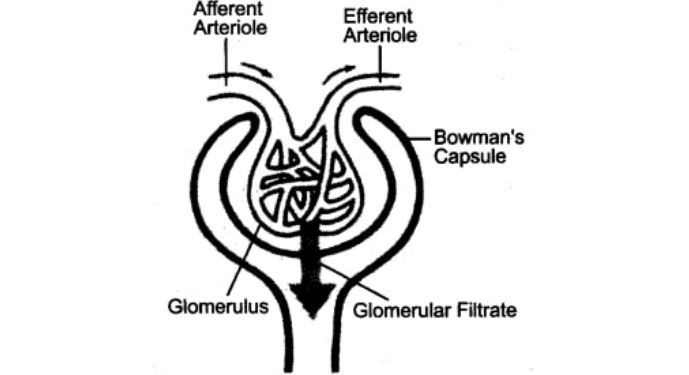
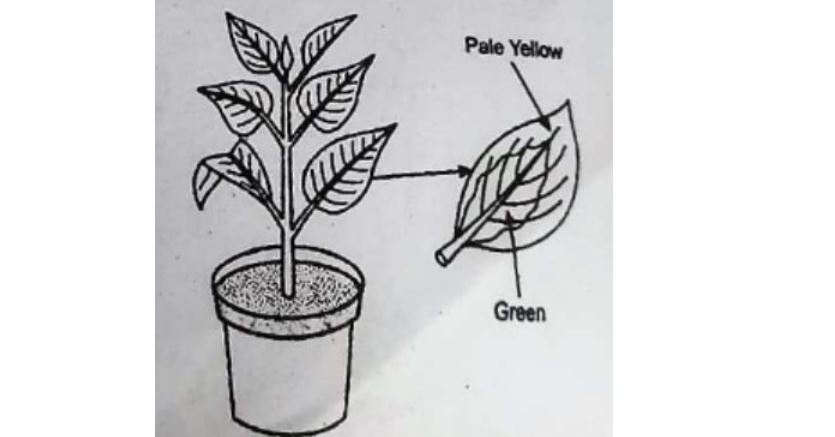
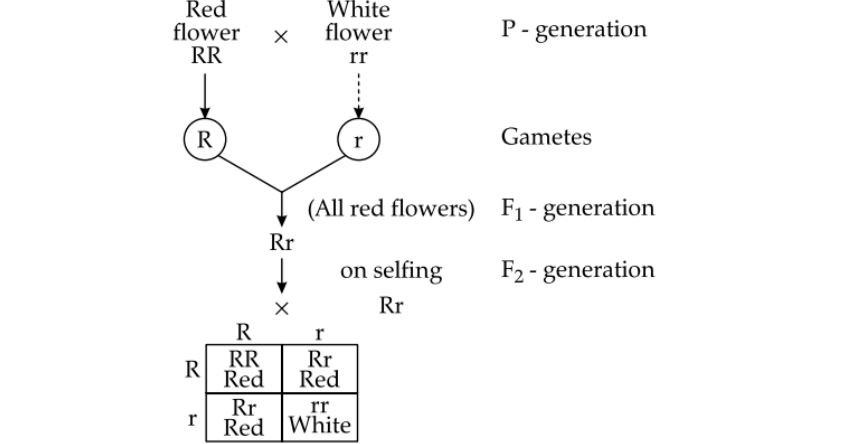
Comments
All Comments (0)
Join the conversation